This article was published in the Martinez News-Gazette on 04/22/2018 and is the twelfth part of our continuing story about Aaron Rice and his family.Our last installment found on November 14, 1872, the Rice family grew when Aaron’s 26-year-old son Nathaniel married 18-year-old Rebecca Donzel with no family members present. Also mentioned in an announcement regarding churches on March 18, 1871 published in the Napa County Recorder, Rev. Robert Rice (Aaron’s father) gave two sermons a day as acting minister for the Napa AME Church, while Nathaniel supervised the Sunday School. Robert also owned the family farm that employed both Aaron and Nathaniel. 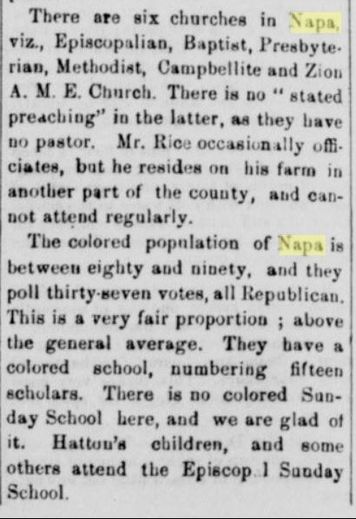 Elevator, 1 November 1873, Courtesy Public Domain Elevator, 1 November 1873, Courtesy Public Domain On Nov. 23, 1873, Elevator newspaper representatives from San Francisco visited Napa to report on its African-American community, and then published their findings on Nov. 30, 1873. An excerpt, “… There are six churches in Napa, viz., Episcopalian, Baptist, Presbyterian, Methodist, Campbellite, and Zion A. M. E. Church. There is no “stated preaching” in the latter, as they have no preacher. Mr. Rice occasionally officiates, but he resides on his farm in another part of the county, and cannot attend regularly. “The colored population of Napa is between eighty and ninety, and they pole thirty-seven votes, all Republican. This is a fair proportion; above the general average. They have a colored school, numbering fifteen scholars. There is no colored Sunday School here, and we are glad of it. Hatton’s children, and some others attend the Episcopal Sunday School. …” It should be noted that the Elevator believed in total integration of African-Americans in all aspects of society including education which help explains their comment. The Pacific Appeal, their rival, believed in the creation of an independent African-American community. 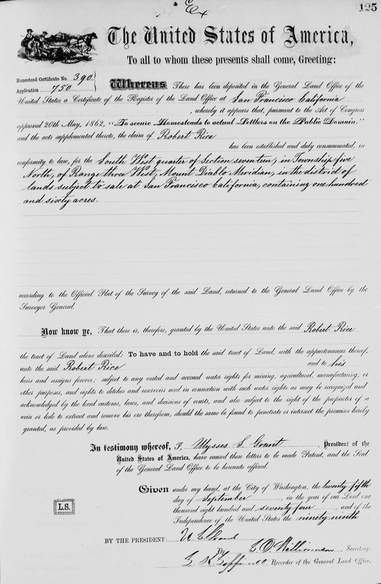 Robert Rice US Land Patent, Courtesy Public Domain Robert Rice US Land Patent, Courtesy Public Domain In the meantime, some important points are raised regarding the Rice family. Rev. Rice in 1871 is regularly conducting two services, while Nathaniel oversees the Sunday School every Sunday. Two years later, he is unable to and the school is gone despite the Napa County’s African-American population having grown from 43 in 1862 to 80-90 in Napa City alone by 1873. By September 25, 1874, the terms of Robert’s May 20, 1862 Homestead Application are fulfilled allowing for the free and clear ownership of the family farm. There is no mention of Charlotte (Aaron’s wife) with whom he purchased the property in 1860 due to married women’s land ownership not being federally recognized. Additionally we found an April 24, 1869 deed stating Robert sells 2/3 of the farm to Aaron for $1. Most likely, this was for Charlotte’s portion of the property. 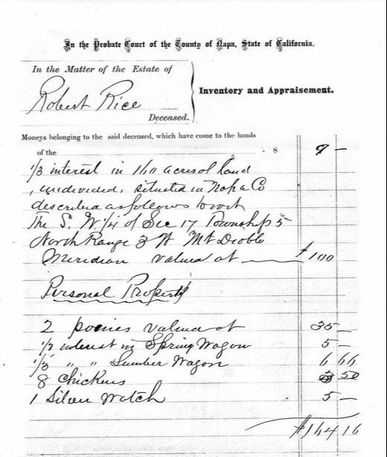 Robert Rice Probate Appraisal, Courtesy Public Domain Robert Rice Probate Appraisal, Courtesy Public Domain On March 20, 1875, tragedy begins to befall the Rice family as 75 year old Rev. Robert Rice dies from dropsy (edema caused by heart congestion today). His estate consisted of, cash & coin - $9, 1/3 of the family farm - $100, 2 ponies - $35, 1/3 interest in spring wagon - $5, 1/3 interest in lumber wagon - $6.66, 8 chickens - $3.50, silver watch - $5, for a total worth of $164.16 or $3,606.35 today. His probate was settled on May 24, 1875 awarding it all to his widow Dilcy after she paid $100 bond, court costs and unknown attorney fees. Later that year on November 1, Rebecca dies at 21, childless. In researching her death, we made an interesting discovery. Although only her name and age were listed within Napa County records, we were able to find cause of death and more contained within the Tulocay Cemetery’s records. Not only did we learn she died of consumption (tuberculosis today) but that she was also determined to be “Copper” a term used for anyone of Asian descent. This might explain why their wedding had no family present. Then on February 16, 1876, Dilcy age 84 dies of “old age”, followed less than a month later by Charlotte age 64 on March 3, from typhoid fever, a very contagious disease known to thrive in unsanitary conditions regarding water and raw food. Napa County at this time did not have a reliable clean water system and a number of the farmland wells were susceptible to contamination from the bacteria. The close proximity of their deaths makes it highly suspicious and most likely that Dilcy also died of Typhoid, as the elderly and the young were the most vulnerable. All four deaths happened in less than a year, decimating a once strong thriving family unit. We can only imagine the devastating grief Nathaniel and Aaron must have suffered. However, they pressed on and a year and a half later there is joy again.  Marriage Certificate for Annie Elizabeth Dyer and Nathaniel Rice, Courtesy Marriage Certificate for Annie Elizabeth Dyer and Nathaniel Rice, Courtesy On October 31, 1877, Nathaniel age 31 marries again when he weds Edward Hatton’s stepdaughter Annie Elizabeth Dyer age 27. Their witnesses were her stepbrother Joseph Hatton and Fred Sparrow (the first Napain African-American to register to vote) and was officiated by the prominent Rev. Richard Wylie, pastor of the Napa Presbyterian Church. You will recall from our earlier writings that the Hatton’s were the prominent face of the Napian African-American community. Annie and Nathaniel’s wedding therefore is proof of how close the two families were and the prominence the Rice’s must have held. (Interesting side note on their marriage certificate it makes a point to mention that “neither party married before.”) Coming up in the next part of the story, we will be exploring Dilcy’s probate which wasn’t filed until 1880. There are yet more exciting revelations to be divulged in our next column. 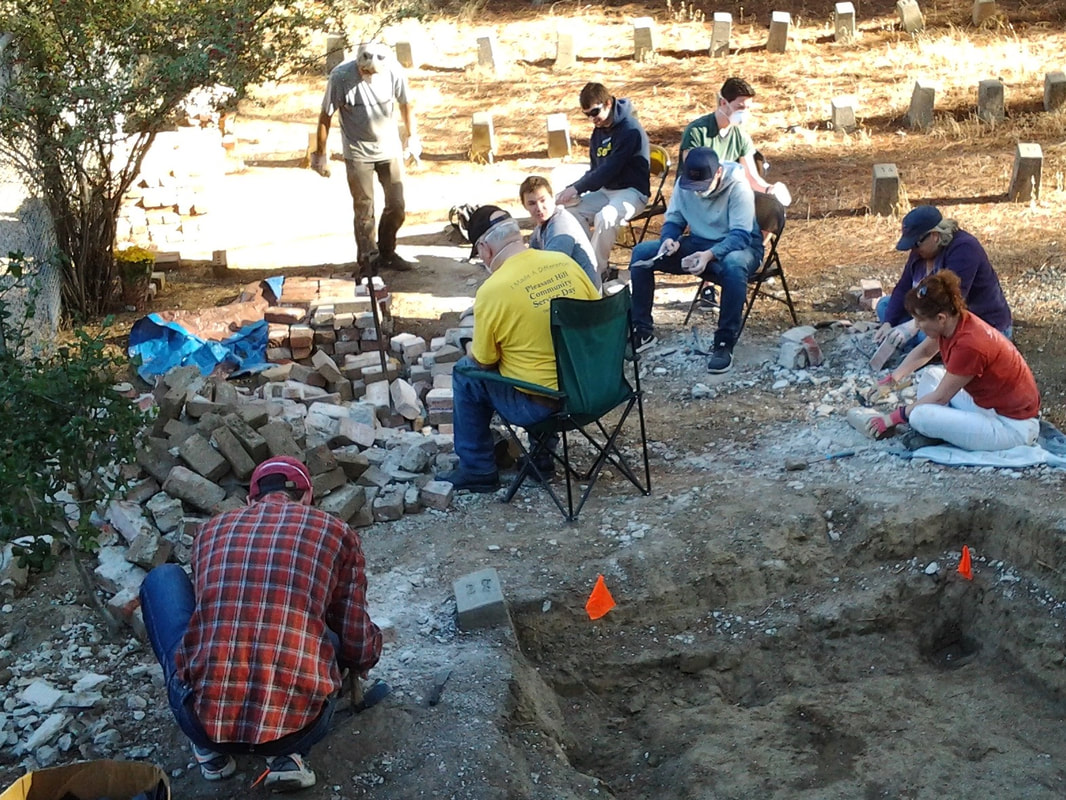 L to R Christopher Lowman, Dan Mosier, John Burgh, Crowley Brynn, Kevin Crane, Kyle Rainey, Devon Knight, Carolyn Knight, Shauna Mudnt, Courtesy L to R Christopher Lowman, Dan Mosier, John Burgh, Crowley Brynn, Kevin Crane, Kyle Rainey, Devon Knight, Carolyn Knight, Shauna Mudnt, Courtesy Coming up on Saturday, May 12 is the first Alhambra Cemetery Cleanup Day and our first Potter’s Field Restoration Project workday of the year sponsored by the City of Martinez and E. Clampus Vitas. The hours are 9am to 2pm, with E. Clampus Vitas providing lunch and SOLS providing refreshments. While there is plenty of work to do to maintain, preserve, and restore this very important outdoor museum, as the story goes, “many hands make light work”. Come join us and be a part of our ever growing volunteer community as a good time is had by all! Lastly and for good measure it’s a chance to visit the site and inspiration behind our columns. Judie & Joseph Palmer are two of the founding members of the Martinez Cemetery Preservation Alliance (MCPA) and the Potter’s Field Project. Both have a passion for discovery, history, genealogy, anthropology and archaeology. For more info, please visit our website MartinezCemetery.org. Do you have a Potter’s Field story to tell? We welcome any pictures or information regarding the Alhambra Pioneer Cemetery or its Potter’s Field. Please email us at [email protected] or call us at (925) 316-6069. This article was published in the Martinez News-Gazette on 04/8/2018 and is the eleventh part of our continuing story about Aaron Rice and his family.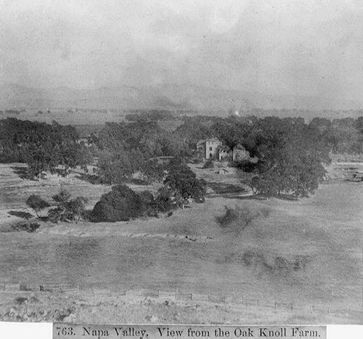 To recap Aaron Rice and his family’s story since they gained their freedom, we created a list of the important events we have covered to date. We started with their first Holidays as free people in 1860, the loss of their son Lewis in 1862, the Civil War from 1861 – 1865, their founding of the Napa AME Church in 1867, and finally the ratification of the 14th and 15th Amendments to the US Constitution giving them full citizenship in 1870. In this iteration, we highlight their relative peace, prosperity and happiness from 1860 – 1873 with additionally discovered information and events. Despite all of them living through enslavement and the dysfunction of William Rice, there was some positives to come out of their trauma. First, they had miraculously remained intact as a family, an uncommon occurrence for former African-American Slaves. Second, they had each gained valuable skills from their forced labor. Both of these factors allowed them to not only survive but also thrive in their new home in Napa, California. 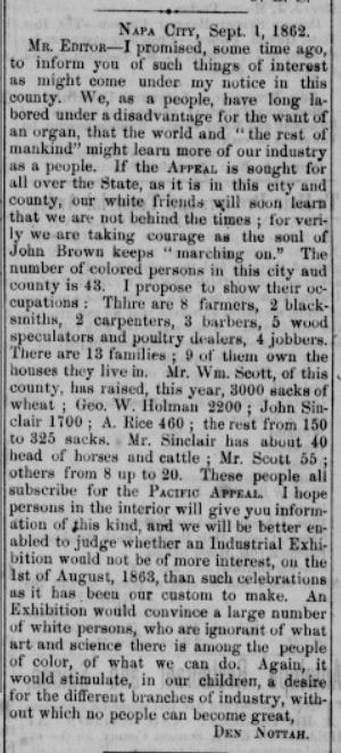 Letter to the Editor from Den Nottah, Pacific Appeal, 6 September 1862, Courtesy Public Domain Letter to the Editor from Den Nottah, Pacific Appeal, 6 September 1862, Courtesy Public Domain The United States Census 1860 Agricultural Schedule 3 shows the previous owner of their 160-acre farm, William Russell (also African-American) did not fulfill the requirements of the Homestead Act by making the necessary improvements. Therefor William sold the property in foreclosure for $100 to Robert and Charlotte. In order not to lose the land themselves, the Rice family had to cultivate crops, and within a couple years build a dwelling. From a letter to the editor of the Pacific Appeal dated Sep 1, 1862, Den Nottah gives a peak into the Rice’s community. He states, “The number of colored persons in this city and county is 43. I propose to show their occupations: There are 8 farmers, 2 blacksmiths, 2 carpenters, 3 barbers, 5 wood speculators and poultry dealers, 4 jobbers. There are 13 families; 9 of whom own the houses they live in. Mr. Wm. Scott of this county, has raised, this year 3000 sacks of wheat; Geo. W. Holman 2200; John Sinclair 1700; A. Rice 460; the rest from 150 to 325 sacks. Mr. Sinclair has about 40 head of horses and cattle; Mr. Scott 55; others from 8 up to 20.” Aaron and Nathaniel would have done most of the wheat harvesting and preparation for its milling. On a good day, they would have used their horse drawn wagon to travel the dirt roads back into town hauling Robert’s grain. They potentially left it with W. R. Cooper’s Flour Mill on the corner of Water and McKinstry. As they turned on to Main Street, they might have dropped in J. B. Murphy’s Candy Factory and Bakery (86 Main St.) and visited their friend, Joseph Hatton at his barber shop (128 Main St). They might also have visited Beebe & Hall (126 & 129 Main St.) or D. B. Parks Harness and Saddles, established in 1852 (120 Main St.) for horse equipment repairs. Along the way they would have viewed the Amelia (1860-1870), a 174-foot steamboat, dock in Napa, delivering the San Francisco Elevator and Pacific Appeal newspapers, dropping off and picking up passengers, local grown products and other goods. Additionally they would observe the Napa Valley Railroad (1864-1869), the first train to run through Napa, bringing additional visitors, settlers, news, and profits, which also increased Robert’s property value. Once enough time had passed, they would return back to the mill for their flour, which they then sold locally, to exporters, or kept for personal use. From which Charlotte and Dilcy would then create baked goods for themselves and for sale at market. Examining US Census data can tell you a lot about an individual and their family. From the United States Census, 1870 it lists the Rice’s under “Dwelling-house” number 576. From the Ninth Census, 1870 Instructions to Assistant Marshalls, a dwelling house meant, “a house standing alone or separated by walls from other houses in a block.” Their “Family Number” is 532, which means all individuals listed under No. 532 live together as family. The first “Head of Household”, shows Robert, Aaron’s father, aged 70, followed by Dilcy aged 74, Aaron aged 49, Nathaniel aged 24, and Charlotte aged 58. Under occupation, Robert is a “farmer”, defined as someone who owns farmland. Dilcy as “keeping house”, defined as a woman, “keeping house for their own families or themselves without any other gainful occupation.” Aaron and Nathaniel are “laborers”, defined as employees, thereby meaning they were employees of Robert. Charlotte has “no occupation.” The next two columns lists property and personal estate value. In the Ninth Census manual, it states, “…farms for the purposes of the Agricultural Schedule include all considerable nurseries, orchards, and market gardens which are owned by separate parties which are cultivated for pecuniary profit, and employ as much as the labor of one able-bodied workman during the year. …no farm will be reported of less than 3 acres, unless five hundred dollars’ worth of produce has actually been sold off from it during the year.” Robert’s column lists his property value at $1,000 ($17,000 today) and his personal estate (furniture, vehicles etc.) at $600 ($9,000 today). Since, Aaron’s columns are left blank we can assume he didn’t own anything. However, Nathaniel has a personal estate of $200 ($3,000 today). Perhaps he owned a cow? Their births are listed as follows, Robert, Dilcy and Aaron in North Carolina, Charlotte in Virginia and Nathaniel in Missouri. Additionally only Robert’s parents are listed as foreign born, which means they were brought here on slave ships. The Census also asked about literacy. Aaron and Charlotte were never taught, Robert and Dilcy could read somewhat but not write, while Nathaniel had the opportunity to learn both. Last note, it is also the first Census listing Robert, Aaron and Nathaniel as United States Citizens. 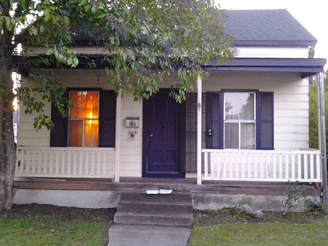 Front of AME Church Today. Front of AME Church Today. From the March 18, 1871 Napa County Reporter, listing all places of worship was an announcement that read, "African Methodist Church, Washington St. — Rev. Robert Rice. Preaching every Sunday at 11 o'clock a.m., and 7 1/2 p.m. Sunday School at 2 1/2 o'clock p.m., Nathaniel Rice, Superintendent." As a family, they would leave their farmhouse together on Sunday mornings and head to their church to fulfill their spiritual obligations. 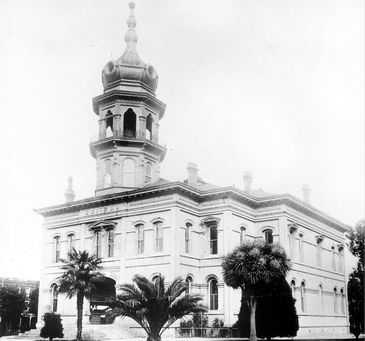 Napa County Courthouse 1879, Courtesy Public Domain Napa County Courthouse 1879, Courtesy Public Domain On November 14, 1872, the Rice’s gained another member as Nathaniel married Rebecca Donzel. They applied for a marriage license that day at the Napa County Court House and not waiting to get married were joined in matrimony by the Rev. G. W. Ford a Baptist Minister. He was on hand to perform their wedding with the County Clerk acting as the witness. This raises the question, why were no family members present? Perhaps they were fearful their families would object? Their wedding announcement appeared in the Elevator on November 23, 1872. It stated, “Married! In Napa City November 14, by Rev. G. W. Ford, Rev. Nathaniel Rice and Miss Rebecca Danzel.” In 1872, their marriage was the 311 registered in Napa County. Judie & Joseph Palmer are two of the founding members of the Martinez Cemetery Preservation Alliance (MCPA) and the Potter’s Field Project. Both have a passion for discovery, history, genealogy, anthropology and archaeology. For more info, please visit our website MartinezCemetery.org. Do you have a Potter’s Field story to tell? We welcome any pictures or information regarding the Alhambra Pioneer Cemetery or its Potter’s Field. Please email us at [email protected] or call us at (925) 316-6069.
|
AuthorsJudie & Joseph Palmer are two of the founding members of the Martinez Cemetery Preservation Alliance (MCPA) and the Potter’s Field Project. Both have a passion for discovery, history, genealogy, anthropology and archaeology. Archives
October 2021
Categories |


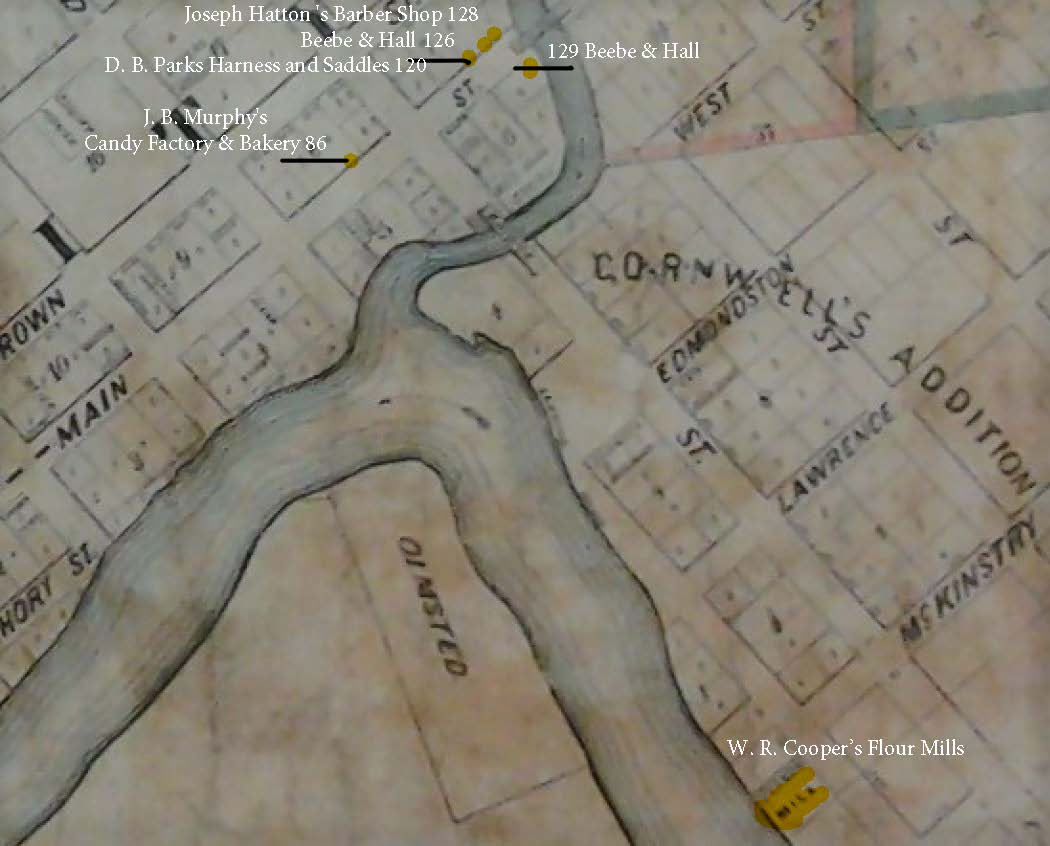
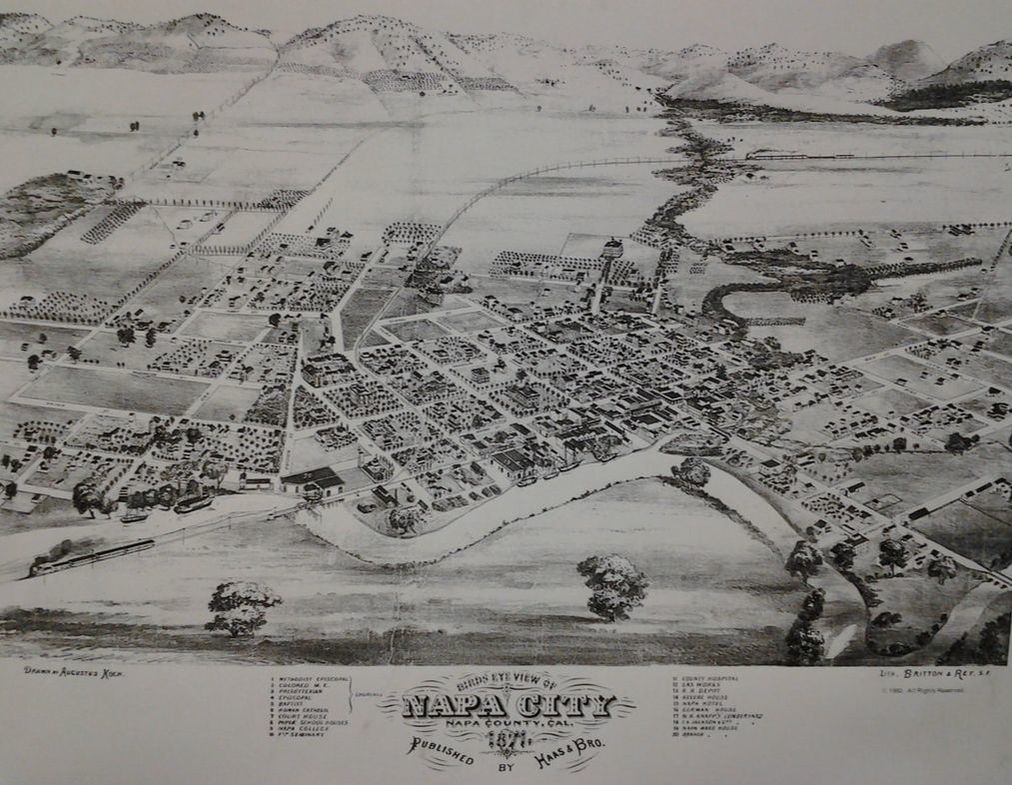



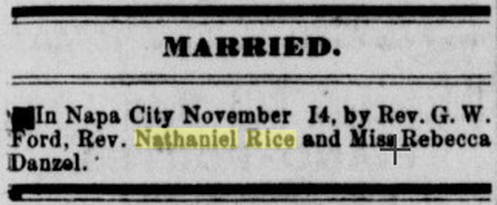
 RSS Feed
RSS Feed